إن Scrum و Kanban متنافسان كلاسيكيان - فهما يشتركان في العديد من القواسم المشتركة، خاصةً كأدوات فعالة ضمن إدارة المشاريع الرشيقة . ومع ذلك، عند النظر إلى الفروق بينهما، يبدو أنهما أقرب إلى التفاح والبرتقال. 🍎
بينما يجسد Scrum نهجًا منظمًا وتكراريًا لإدارة المشاريع و تطوير المنتجات ، يدور كانبان حول تصور العمل وفرض حدود على العمل الجاري، وتحسين الكفاءة. ومع ذلك، هذا مجرد خدش لسطح الاختلافات بينهما.
ستستكشف هذه المقالة النقاش الدائر بين Scrum مقابل Kanban لتحديد حالات الاستخدام المثالية بينهما. بالإضافة إلى ذلك، سنقدم لك نموذجًا عمليًا لـ Agile أداة عملية لإدارة المشاريع التي تسمح لك بتجربة كلا الخيارين بسلاسة. 😉
نظرة عامة على سكرم مقابل كانبان ## Scrum مقابل كانبان
يعد كل من Scrum و Kanban نظامي عمل تكراري يعتمدان على تدفقات العمليات ويشتركان في الهدف المشترك المتمثل في تقليل الهدر. ومع ذلك، هناك العديد من الفروق الجديرة بالملاحظة بين النهجين:
| الرؤية | كانبان | كروم |
|---|---|---|
| الأصول | تطوير البرمجيات | التصنيع الرشيق |
| الأدوار والمسؤوليات | لا توجد أدوار محددة مسبقًا | أدوار محددة مع Scrum Master و Product Owner |
| التفويض وترتيب الأولويات | "نظام السحب" لإنجاز المهام الفردية | "نظام السحب" مع سحب الدفعة بأكملها لكل تكرار |
| تواريخ الاستحقاق والجداول الزمنية للتسليم | التسليم المستمر حسب الحاجة | التسليم القائم على السرعة مع تحديد فترات زمنية محددة للإنجاز والمراجعة |
| قياس الإنتاجية | قياس زمن الدورة الزمنية لإنجاز المشروع | قياس السرعة من خلال سباقات السرعة وميزات تتبع التقدم التكراري |
| التعديلات | يسمح بإجراء تغييرات في منتصف المشروع من أجل التحسين المستمر | لا يتم تشجيع التغييرات بشكل عام أثناء سباقات السرعة |
| المفاهيم الرئيسية | فعالة ويمكن التنبؤ بها | شفافة وقابلة للتكيف |
| أفضل التطبيقات | مشاريع ذات أولويات متفاوتة على نطاق واسع | فرق ذات أولويات مستقرة نسبيًا قد لا تتغير بشكل كبير |
ما هو سكروم؟
هل تساءلت يومًا عن علاقة الفريق عالي الأداء بتشكيلة سكروم الاستراتيجية؟ تعرّف على إطار عمل سكروم، وهو مفهوم صاغه هيروتاكا تاكيوتشي وإيكوجيرو نوناكا. لا تقلق، فالأمر لا يتعلق بالتعامل مع الخصوم - بل هو مغير لقواعد اللعبة في إدارة المشاريع! 🏈
دعونا نكشف النقاب عن عالم Scrum المثير ، ونستكشف فوائده، ونكتشف أين يمكن أن يكون له تأثير حقيقي في تخطيط سباقات السرعة ونحو الفرق متعددة الوظائف!
سكروم: التعريف
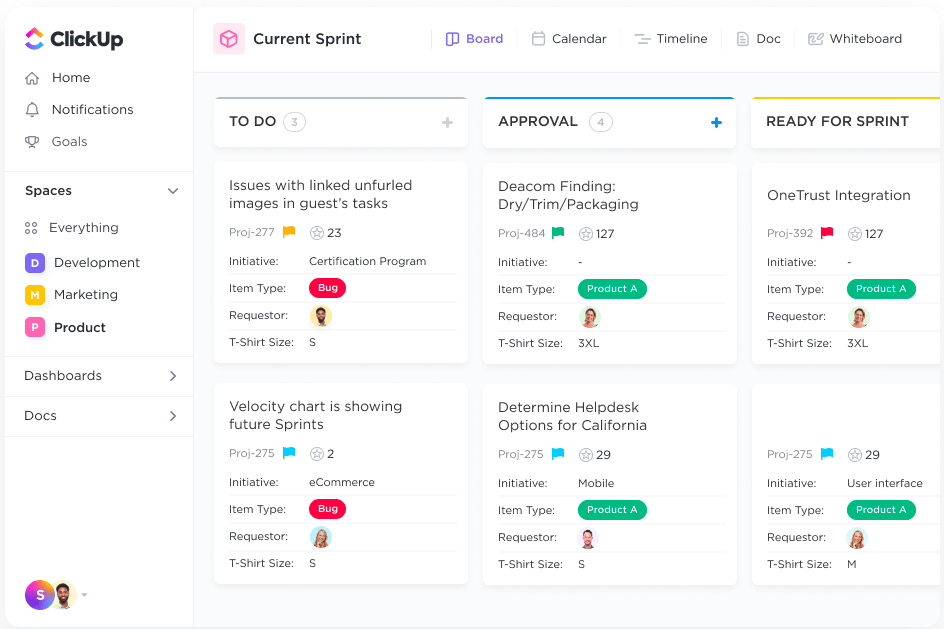
تحافظ سباقات السرعة في ClickUp على توافق الفرق حول خرائط طريق المنتج للحصول على رؤية كاملة حول من يقوم بماذا
سكرم هو إطار عمل ضمن منهجية أجايل التي توفر مجموعة من الأدوار والاحتفالات والمصنوعات اليدوية لهيكلة وتوجيه عملية التطوير التكراري. إنه مصمم خصيصًا للمشاريع المعقدة التي تتطلب التكيف المتكرر مع التغييرات.
يدور سكروم حول دورات تطوير قصيرة تُعرف باسم سباقات السرعة التي تستمر عادةً من أسبوع إلى أربعة أسابيع. غالبًا ما تكون فرق سكروم صغيرة وذاتية التنظيم، وتتألف من مدير سكروم (فكر في مدير مشروع مخصص)، ومالك المنتج، و فريق تطوير المنتج . 👥
بما يتماشى مع المبادئ الرشيقة يتم إنجاز المهام وتسليمها على مراحل بدلاً من تسليم المشروع بأكمله دفعة واحدة. يسمح هذا النهج التدريجي لفرق سكرم بالعمل من خلال تراكمات سريعة ويعزز قدرتها على التكيف مع التغييرات وتغيير الأولويات بسهولة.
ثلاث ركائز أساسية تدعم سكروم:
- التكيف: يستوعب بسهولة التحولات في اتجاهات المشروع
- الشفافية: يضمن إطلاع الجميع في فرق سكروم على ما يحدث ولماذا يحدث
- التفتيش: التفتيش المنتظم على المشاريع يعزز ثقافة التحسين المستمر بين أعضاء فريق سكروم وأصحاب المصلحة
تشمل القيم الأساسية لسكروم التركيز والشجاعة والاحترام والالتزام والانفتاح. وهي تدعم التواصل الواضح والصادق وتعزيز الشعور بالملكية بين فريق التصميم أو تكنولوجيا المعلومات أو العمليات أو التطوير.
ما هي فوائد استخدام Scrum؟
من بين الأطر الرشيقة، تشمل فوائد اعتماد Scrum ما يلي:
- ارتفاع رضا العملاء: تضمن المشاركة النشطة للعملاء في تطوير المنتج أن البرنامج مخصص لتلبية احتياجاتهم
- زيادة التعاون: زيادة التعاون: صغيرة ومتماسكة بإحكامفرق سكروم خلق تواصل فعال وإحساس بالملكية على عملهم
- القدرة على التكيف مع التغيير: يسمح النهج التكراري لسكروم بالمرونة في التكيف مع التغييرات والأولويات المتطورة، مما يجعله مناسبًا تمامًا لبيئات المشاريع الديناميكية
- تخفيض التكاليف: يؤدي التسليم المبكر للمنتج إلى توفير الوقت والتكاليف. كما أن القدرة على إجراء تغييرات سريعة تقلل أيضًا من الحاجة إلى موارد إضافية للتكيف مع المتطلبات المتطورة
- زيادة العائد على الاستثمار : كلما كان المنتج أسرع في الوصول إلى السوق، كلما بدأ عملك في تحقيق إيرادات أسرع. تساهم كفاءة سكروم في إيصال المنتجات إلى السوق بسرعة في تعزيز العائد على الاستثمار
متى يجب عليك استخدام سكروم؟
يرتبط سكروم بما يلي زيادة الإنتاجية وتسليم أسرع، وتوفير في التكاليف، وتحسين جودة المنتج. وغالبًا ما يجد المديرون أنها فعالة بشكل خاص للتعامل مع المشاريع المعقدة أو تلك التي تخضع لتعديلات متكررة.
يعد استخدام Scrum رائع للصناعات التي تتميز بالتغييرات المستمرة أو المشاريع التي تتطلب مرونة في التكيف مع التغذية الراجعة. وينطبق هذا بشكل خاص على الصناعات التي تخضع لتحديثات تقنية متكررة أو المشاريع التي تنطوي على تحديثات جديدة تطوير البرمجيات . 💻
استخدام ClickUp لإدارة Agile و Scrum بكفاءة
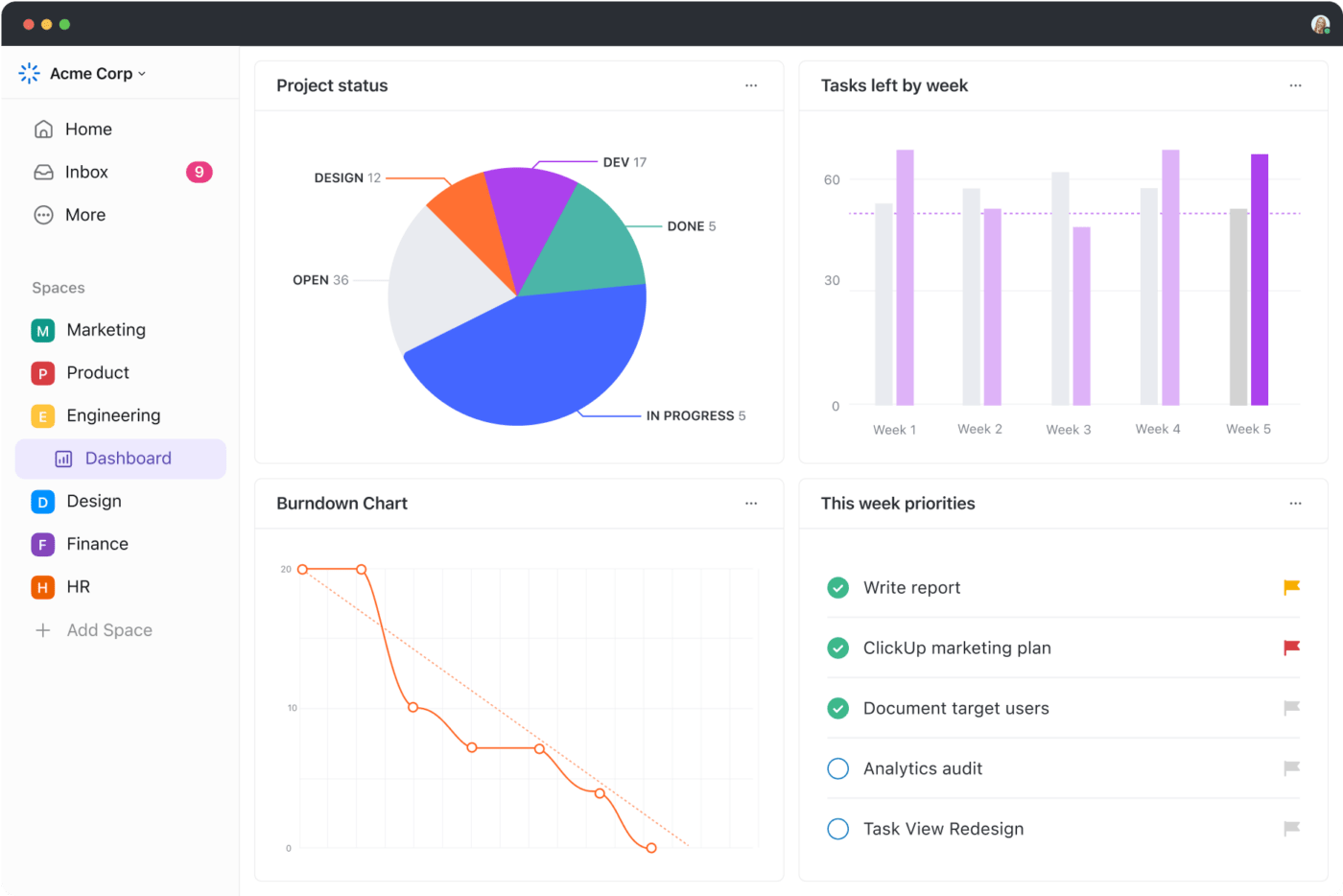
توفر لوحات المعلومات في ClickUp لمديري المشاريع الرشيقة عرضًا سريعًا للمهام والأولويات المتبقية للفريق خلال الأسبوع، بالإضافة إلى مخططات تفصيلية لمراحل الإنجاز والتراجع
لإطلاق الإمكانات الكاملة ل إدارة مشروع سكروم ، استخدم انقر فوق كحل سهل الاستخدام متعدد الإمكانات ل Scrum و فرق العمل الرشيقة .
السيطرة على دورة حياة المنتج بالكامل، بدءًا من التصور وحتى الإصدار، مع ميزات ClickUp Agile Project Management . قم بإنشاء مهام سير عمل المنتج التي تتكيف بمرونة مع احتياجاتك، وتأكد من بقاء الفريق على اطلاع دائم من خلال التعليقات الموسومة بالعلامات، وابقَ على اطلاع دائم بالإشعارات في الوقت المناسب. 🔔
مؤتمتة لوحات معلومات ClickUp توفر رؤى قيّمة حول تقدم الفريق وقدراته، وتقدم رؤية شاملة لمشروعك. تصور العمليات على الرسوم البيانية المختلفة لفهم واضح وتصور مشروعك من خلال ميزات مثل:
- التسجيل: تقييم التأثيرات والمفاضلات لأفكار المنتج والمشكلات والميزات الجديدة باستخدام الحقول والصيغ المخصصة
- لوحات: تحديد الاختناقات للحفاظ على زخم المشروع. قم بفرز اللوحات حسب الحالة وتاريخ الاستحقاق والأولوية لمواءمة فريقك بشكل فعال
- خرائط الطريق: تنظيم سباقات السرعة وإدارة المراحل الرئيسية باستخدام مخططات جانت القابلة للتخصيص
- اللوحات البيضاء :العصف الذهني كفريقوإنشاء المخططات والخرائط الذهنية وترجمة الأفكار بسلاسة إلى مهام قابلة للتنفيذ
- عرض عبء العمل : تتبع المهام المكتملة وتفويض العمل بناءً على مدى توفر فريقك، كل ذلك في موقع مركزي واحد
تشغيل سباقات السرعة الآلية على ClickUp سباقات النقر السريع ارتقِ بالتعاون إلى المستوى التالي من خلال دمج العناصر الأساسية مثل تواريخ السباقات السريعة والأولويات ونقاط السباقات السريعة. استخدم
المخططات الموضوعة لمراقبة الأداء مقابل الخط المستهدف و مخططات الاحتراق لتتبع المهام المكتملة ونطاق العمل المتبقي.
الاعتماد على مخططات السرعة لتقييم متوسط إنجاز المهام وإجراء تقديرات أكثر دقة لسباقات السرعة المستقبلية. هل تريد منظورًا متعدد الأطر الزمنية لتقدم المهام للمساعدة في تحديد الاختناقات؟ استخدم مخططات التدفق التراكمي للحصول على الصورة الكاملة
ليس عليك أن تبدأ رحلة الإدارة الرشيقة من المربع الأول. استخدم ClickUp نموذج إدارة Agile Scrum للإدارة الرشيقة لمراقبة الأعمال المتراكمة، وسباقات السرعة، والمراجعات دون عناء. إنه يدعم الفرق التي تتعامل مع المشاريع المعقدة، ويأتي مع مجلدات منفصلة لاحتفالات سكروم والتراكمات والينابيع، بالإضافة إلى عرض السبورة البيضاء للعرض المرئي التخطيط السريع . 📊

قالب إدارة مشروع سكرم الرشيق من ClickUp
ما هو كانبان؟
كانبان هو نموذج قوي مساعد إدارة المشاريع ! سواء كنت تعتمد على Scrum أو أي طريقة رشيقة أخرى، يعمل كانبان على تحسين وتبسيط عملك. لا يتعلق الأمر فقط بالمنهجية - بل يتعلق بتصور و تحسين سير العمل . دعونا نتعمق في فوائده الخاصة وأفضل حالات الاستخدام! ⛏️
كانبان: التعريف
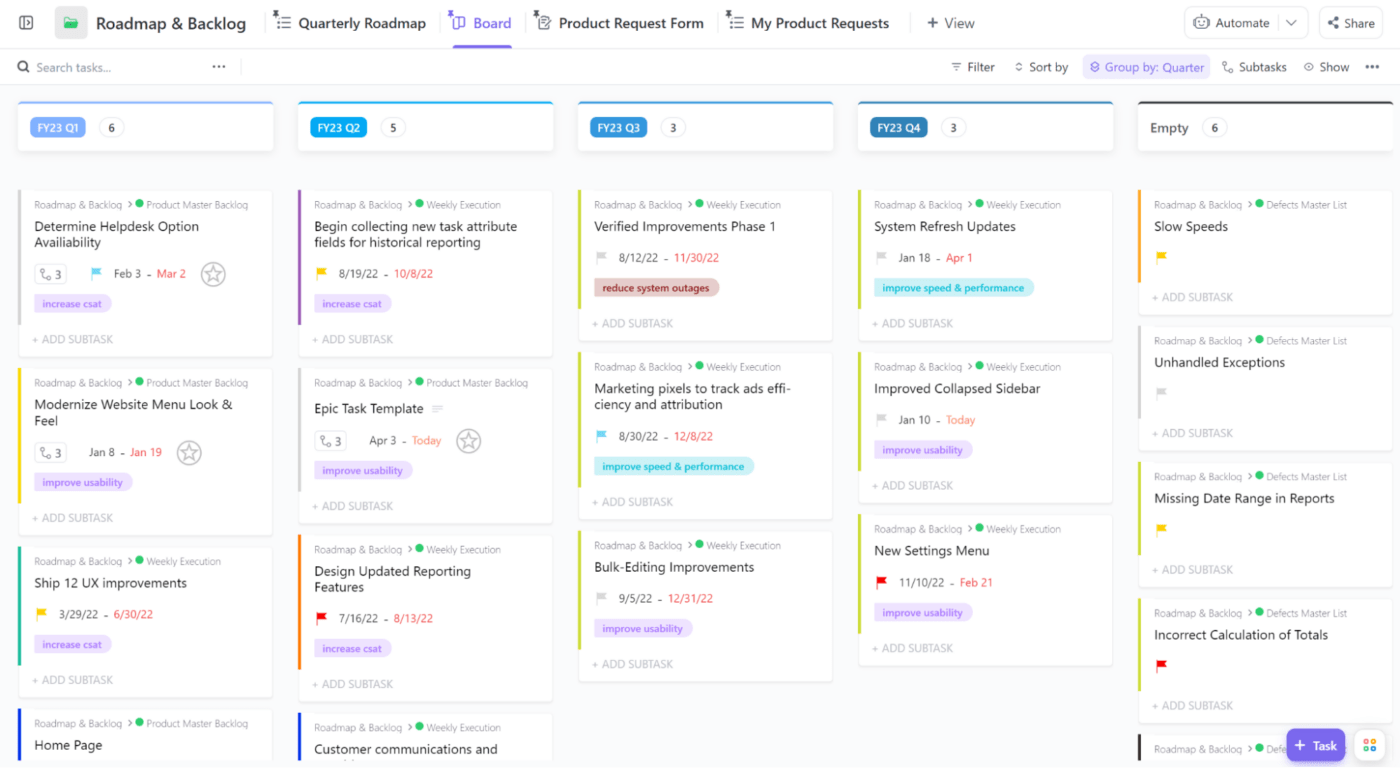
استخدم لوحات Kanban في ClickUp لإدارة المهام بصريًا من خلال إجراء سحب وإفلات بسيط
كانبان هو إدارة المشاريع المرئية أداة مصممة لتتبع المهام وتعزيز كفاءة المشروع بشكل عام. يوجد في جوهرها أداة مادية أو رقمية لوحة كانبان التي تصنف مراحل المشروع إلى أعمدة متميزة.
يتم تمثيل مهام المشروع على شكل ملاحظات لاصقة أو بطاقات كانبان على هذه اللوحة، وتعكس حركتها عبر الأعمدة تقدم المشروع.
يوفر تصور المهام بهذه الطريقة رؤى في الوقت الفعلي لأنشطة الفريق، مع تصفيتها حسب التقدم أو الأولويات أو تواريخ الاستحقاق أو أي معايير أخرى. إنه يشبه امتلاك كرة بلورية، حيث يقدم لمحة عن المهام الجارية ويسمح لك بالتنبؤ بالاختناقات المحتملة ومعالجتها قبل أن تعطل التقدم المستقبلي. 🔮
ما يجعل كانبان أكثر تنوعًا هو القدرة على التعايش مع نظام أجايل و منهجيات اللين . إنها تقترن بشكل متكرر مع Scrum في عملية هجينة تسمى سكرومبان التي تُظهر قدرتها على التكيف وفعاليتها في سيناريوهات إدارة المشاريع المتنوعة.
ما هي فوائد استخدام كانبان؟
تشمل المزايا الرئيسية لتطبيق طريقة كانبان ما يلي:
- تعزيز رؤية سير العمل: يوفر تمثيلًا مرئيًا واضحًا لتدفق المهام في جميع أنحاء المشروع من خلال تصنيف مراحل العمل كبطاقات على لوحة كانبان
- تنفيذ أسرع للعملية: من خلال التتبع المرئي للمهام وإدارتها، يمكن للفرق تحديد الاختناقات ومعالجتها على الفور، مما يقلل من التأخير
- زيادة القدرة على التنبؤ: يمكن للفرق توقع أنماط العمل، وتحديد التحديات المحتملة، واتخاذ قرارات مستنيرة بناءً على معلومات في الوقت الفعلي
- تعاون أفضل: يشجع كانبان التعاون من خلال توفير منصة مشتركة حيث يمكن للفرق تصور المهام وإدارتها وتتبعها. تعزز هذه البيئة التعاونية الشعور بالمسؤولية المشتركة وتعزز العمل الجماعي
- مرونة التكيف: سواء تم استخدام كانبان بشكل مستقل أو مع منهجيات أخرى مثل Scrum، فإن كانبان يتكامل بسلاسة ويتكيف مع متطلبات المشروع المتنوعة
متى يجب عليك استخدام كانبان؟
تم تبني لوحات كانبان في البداية من قبل مديري تكنولوجيا المعلومات وفرق تطوير البرمجيات، وقد وجدت الآن لوحات كانبان اعتماداً واسع النطاق في مختلف المؤسسات. تُعد لوحات كانبان مفضلة بشكل خاص من قبل الفرق التي تمارس منهجيات اللين والرشاقة، حيث توفر لوحات كانبان الرؤية والشفافية الضروريتين لتحقيق مرونة الأعمال. 🤸🏼
يمكن للفرق المشاركة في العمليات المتكررة الاستفادة من لوحات كانبان لإضفاء الوضوح على سير عملهم، وتعزيز عملياتهم، والعمل بكفاءة متزايدة. إن قدرة طريقة كانبان على التكيف تجعلها أداة قيّمة لفرق كانبان في مختلف الصناعات التي تسعى إلى تبسيط عملياتها وتعزيز الفعالية الشاملة.
تصور المهام دون عناء مع طريقة عرض لوحة كانبان من ClickUp Kanban Board

استخدم طريقة عرض لوحة Kanban Board في ClickUp لسحب المهام وإفلاتها بسهولة كبطاقات
استفد من ClickUp كـ حل برمجيات كانبان المجاني لتصور سير عملك في مكان واحد! 🎯 عرض لوحة كانبان ClickUp Kanban بتحويل قوائمك الأساسية إلى بطاقات مهام تفاعلية، وترتيبها بسهولة حسب الحالة أو تاريخ الاستحقاق أو أي معايير تختارها. تعمل واجهة السحب والإفلات سهلة الاستخدام على تبسيط التنقل، مما يتيح لك تعديل الأولويات والحالات بسهولة.
قم بتكييف لوحتك لتناسب أي سير عمل، سواءً كان ذلك يتضمن سباقًا سريعًا أو إطلاق منتج أو تسليمًا متعدد المراحل. يمكنك تبسيط تحديثات مهامك باستخدام شريط أدوات العمل الجماعي يسمح لك بإضافة مكلفين وتغيير الحالات وحذف المهام دون مغادرة عرض اللوحة.
بالنسبة لأولئك الذين يتنقلون بين لوحات متعددة، فإن عرض كل شيء لقطة مركزية لجميع لوحات كانبان الخاصة بك. يمكنك أيضًا تصفية اللوحات حسب المكلفين لتتبع من يتعامل مع ماذا من أجل نهج إدارة المشروع! 🦅
إذا كانت فكرة إنشاء اللوحات من الصفر تبدو مملة، يمكنك الاستفادة من ClickUp قالب لوحة كانبان البسيطة -تخطيط مصمم مسبقًا يمكنك تخصيصه حسب احتياجاتك.
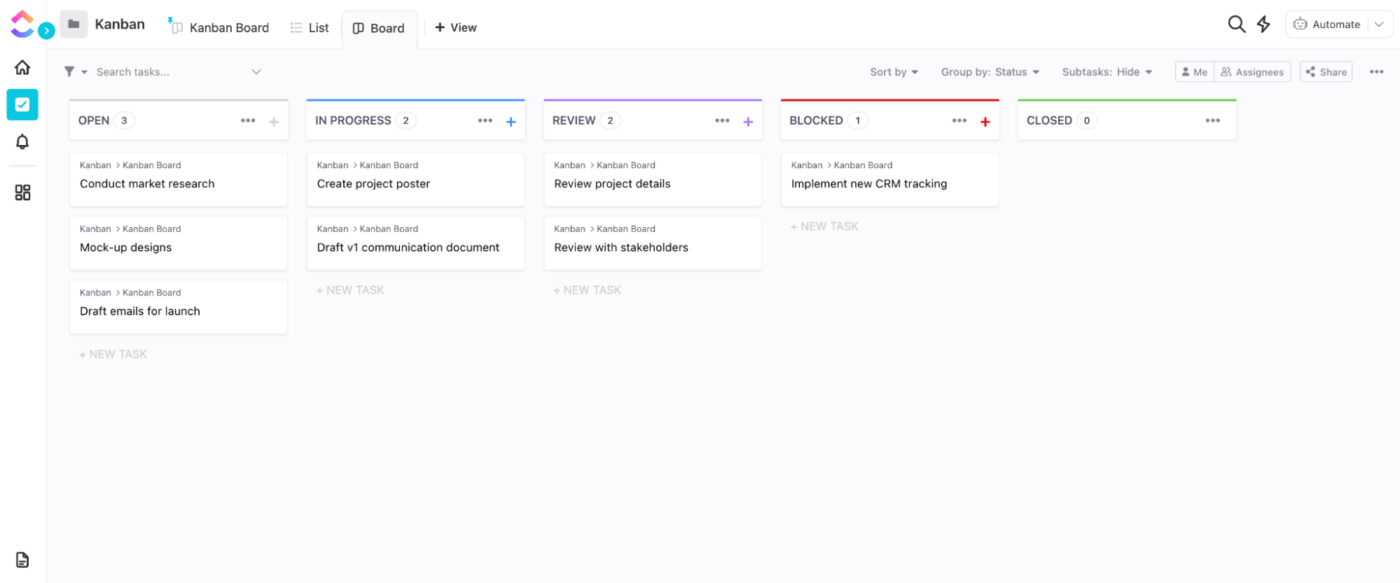
يغطي قالب ClickUp Simple Kanban قالب كانبان البسيط جميع الأساسيات للبدء في استخدام طريقة كانبان في أسرع وقت ممكن
ابدأ في تحسين دورة الإصدار من خلال استخدام خمس حالات لتتبع المهام قيد التنفيذ أو المكتملة أو على قائمة المهام .
انقر على خيارات التجميع في الزاوية العلوية اليمنى لعرض المهام مرتبة حسب الحقول المخصصة مثل الأولوية أو المُعيَّن أو تاريخ الاستحقاق. استفد من شريط الأدوات متعدد المهام لإجراء تغييرات على العديد من المهام بكفاءة في وقت واحد ورفع المظهر المرئي للوحة باستخدام صور الغلاف.
ما هو الفرق الرئيسي بين Scrum و Kanban؟
في حين أن كلاهما له استخدامات في إدارة المشاريع الرشيقة يختلف كانبان وسكروم بشكل كبير. يتميز Scrum بنهج العمل التكراري والتدريجي، حيث يقدم طريقة تصنيفية للغاية لإكمال المهام.
من ناحية أخرى، يعمل Kanban بشكل أفضل عند استخدامه جنبًا إلى جنب مع Scrum أو أي طريقة رشيقة أخرى. وتتمثل وظيفته الأساسية في تصور وتحسين تدفق العمل، بغض النظر عن المنهجية المتبعة.
لفهم الاختلافات بينهما بشكل أفضل، دعنا نتعمق في ثلاثة فروق رئيسية بين كانبان وسكروم. 🔑
1. سكرم مقابل كانبان: التخطيط
في Scrum، التخطيط في Scrum هو عملية تكرارية تحدث في بداية كل سباق. وتتضمن هذه العملية اجتماعًا مخصصًا يتعاون فيه فريق التطوير ومالك المنتج وسكروم الرئيسي لتقسيم قصص المستخدمين إلى مهام يمكن إدارتها.
بعد تقدير الوقت اللازم لإكمال المهام، يلتزم الفريق بإنهاء جميع العناصر في السباق القادم. إذا حدث تغيير في الأولويات في وقت لاحق، فإن ذلك يتطلب إجهاض العدو الحالي، ويتم إعادة تشغيل عملية التخطيط. 🔁
على العكس من ذلك، يعتمد التخطيط في كانبان على تنبؤ يستند إلى بيانات سير العمل التاريخية. يأخذ هذا النهج في الاعتبار عوامل مختلفة تتعلق بالعمل نفسه، مثل أنواع العمل وحجمه وفئات الخدمة، بدلاً من التركيز على الفريق الذي يقوم بمعالجته.
إن سير العمل مستمر، لذا يمكنك إنشاء أعمدة خارطة طريق مثل هذا الشهر أو الشهر القادم لتمثيل العمل المخطط له بشكل مرئي.

قم بإضافة نقاط سباق السرعة والمكلفين المتعددين والمرفقات والعلامات والمزيد إلى لوحة كانبان الخاصة بك في غضون نقرات في عرض لوحة ClickUp لتعزيز كفاءة فرق كانبان
2. سكرم مقابل كانبان الاجتماعات والأحداث
في Kanban، الاجتماعات اختيارية، ولكن إذا اخترت عقدها، فهناك نوعان: إيقاعات على مستوى الفريق وإيقاعات موجهة للخدمة. تساعد هذه الاجتماعات في الحفاظ على مواءمة الفريق وسير عمل ثابت. تشمل الخيارات ما يلي الاجتماعات اليومية ، واجتماعات تجديد الموارد والالتزام، وتخطيط التسليم، ومراجعات تقديم الخدمات، وغيرها. 🤝
من ناحية أخرى، في Scrum، يتضمن النهج المنظم في Scrum أربعة اجتماعات أساسية ضمن كل دورة سبرنت، وعادة ما تستمر حتى 8 ساعات إذا كانت الدورة شهرية. وتشمل هذه الاجتماعات:
- التخطيط للسباق السريع
- سكروم اليومي
- مراجعة سبرينت
- مراجعة سبرينت سبرينت
تضمن هذه الاجتماعات التخطيط الشامل، وتحديثات التقدم اليومية، وجلسات المراجعة، وجلسات المراجعة والاستعراضات الاستعراضية العاكسة للتحسين المستمر.
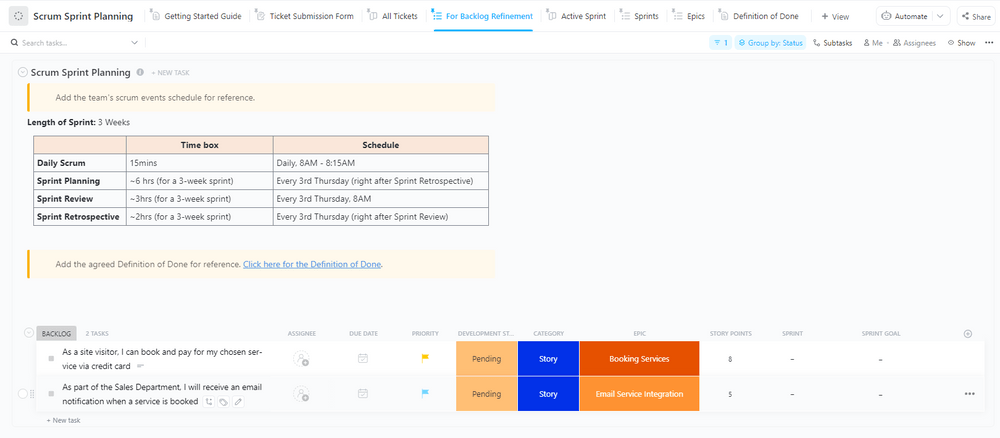
خطط لسباقات السرعة باستخدام هذا القالب سهل الاستخدام للحفاظ على مرونة وفعالية الفرق
3. سكروم مقابل كانبان اللوحات لوحات سكروم بمثابة امتدادات ل
تراكم المنتجات . عندما يلتزم الفريق بكمية محددة من العمل، تتم إضافتها إلى الأعمال المتراكمة على لوحة Scrum، ثم يبدأ الفريق في العمل على المهام حسب تقديره. الهدف من ذلك هو إكمال جميع المهام بحلول نهاية السباق السريع، مما يؤدي إلى إعادة تعيين اللوحة المنطقية بعد كل تكرار.
وعلى العكس من ذلك، فإن لوحة كانبان هي خريطة مستمرة لعملية الفريق. وعند إنشائها، فإن الهدف هو إنشاء نظام كانبان مستدام مصمم للاستمرار على المدى الطويل. تتضمن لوحة كانبان جيدة التنظيم حدودًا مرئية للعمل الجاري (WIP).
والهدف الأساسي هو تنظيم كمية العمل التي تدخل العملية وتخرج منها، مما يعزز سرعة التسليم. ⚡
ما الأداة الأفضل؟
الاختيار بين إطاري كانبان وسكروم هو خيار يتأثر بالتفضيلات الشخصية أو احتياجات المشروع. إذا كنت غير متأكد من أيهما تختار، فكر في استخدام ClickUp لتجربة كلا الإطارين. 👩🏻🔬
لتبسيط عملية اتخاذ القرار، اسأل نفسك الأسئلة التالية:
- هل يتطلب المشروع تخطيطاً مكثفاً؟
- هل الأعمال المتراكمة للمنتج واسعة النطاق أم موجزة؟
- هل ميزانية تطوير المنتج الخاصة بالعميل كبيرة أم محدودة؟
- هل فريقك متمرس أم جديد على منهجيات أجايل؟
- هل لديكفرق متعددة الوظائف أم فرق تقليدية؟
بشكل عام، اختر كانبان إذا كنت تسعى إلى تحقيق المرونة والقيمة للمشروع تصور سير العمل من خلال المقاييس. اختر Scrum إذا كان مشروعك ينطوي على تعاون مكثف بين الفريق, التغذية الراجعة السريعة والالتزام بالتفاني المستمر في المشروع.
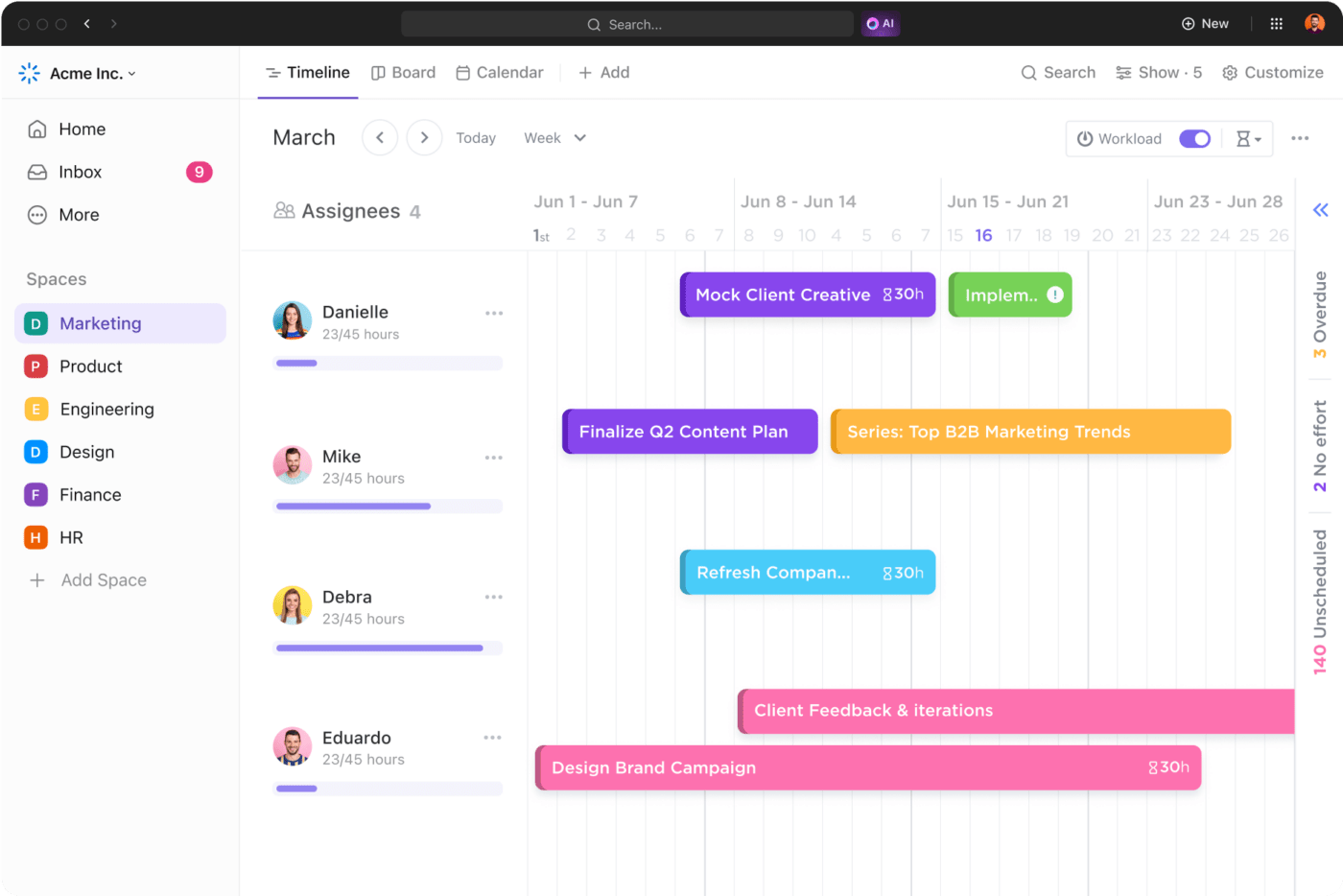
قارن بصريًا بين أعباء عمل الفريق وتتبع التقدم باستخدام طريقة عرض ClickUp Timeline
إذا كنت لا تزال تجد صعوبة في اتخاذ القرار، لماذا لا تجمع بينهما؟
يسخّر Scrumban عمليات Scrum المنظمة جنبًا إلى جنب مع أدوات التصور في Kanban. بالنسبة للفرق التي تعرف بالفعل إما Scrum أو Kanban، يوفر Scrumban أو لوحة Scrum طريقة سلسة لدمج جوانب المنهجية الأخرى في عملياتهم.
أطلق العنان لقوى Scrum و Kanban في ClickUp!
إن الاختيار بين Scrum و Kanban يشبه الاختيار بين Pepsi و Kanban - فكلاهما يأتي مع نقاط قوته المميزة. فمثل المعجبين المتحمسين لهذين العملاقين من عمالقة المشروبات الغازية، تقسم فرق المشروع بشغف إما بتطوير البرمجيات السريع في Scrum أو بسير عمل Kanban المبسط.
تمامًا كما تستحق الصودا المثالية كأسًا ملائمًا، ClickUp هو الحل الأمثل لإدارة المشاريع الرشيقة. وبفضل ميزاته القوية، بما في ذلك قوالب لوحة كانبان والمسابقات السريعة والمخططات البيانية ، يحول ClickUp إدارة المشروع إلى تجربة منعشة.
لماذا لا تأخذ رشفة من النجاح و جرب ClickUp مجانًا ? مع وجود مركز واحد لإدارة مشاريعك، ستجد أنه مزيج مثالي من إمكانيات Scrum أو Kanban. 👌

